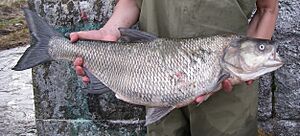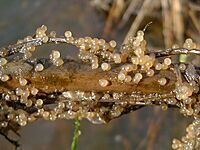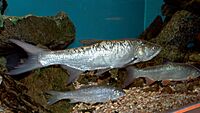Asp (fish) facts for kids
Quick facts for kids Asp |
|
|---|---|
 |
|
| Conservation status | |
| Scientific classification | |
| Genus: |
Leuciscus
|
| Species: |
aspius
|
| Synonyms | |
|
|
The asp (Leuciscus aspius) is a cool freshwater fish found in Europe. It belongs to a big family of fish called Cyprinidae, which includes carps and minnows. Scientists sometimes group it with another fish in the Aspius genus. The asp is important enough that it's protected by an agreement called the Bern Convention. It's also listed as "least concern" on the IUCN Red List, meaning it's not currently in danger of disappearing.
About the Asp
Asps are usually between 10 and 80 centimeters (about 4 to 31 inches) long. Some can grow much bigger, reaching up to 120 centimeters (about 47 inches). The heaviest asps can weigh around 12 kilograms (about 26 pounds).
Where Asps Live
These fish like to live in lakes and the lower parts of rivers. They can also be found in areas where rivers meet the sea, called estuaries.
You can find asps in many European countries. These include Estonia, Lithuania, Latvia, Germany, Norway, Sweden, and Finland. They also live in the Czech Republic, Poland, Ukraine, Bulgaria, Romania, and Russia. Other places they call home are Switzerland, Slovenia, the Netherlands, and Belgium.
Asps have even traveled through the Rhine–Main–Danube Canal. This waterway connects different rivers, allowing asps to spread to Serbia, Croatia, Austria, Hungary, and Slovakia. In eastern Europe, asps are quite common in flowing waters. They are a popular fish for people who enjoy fly fishing and other types of fishing.
Life Cycle of the Asp
From April to June, asps move from lakes into smaller streams. This is when they go to lay their eggs, a process called spawning. Spawning starts when the water temperature rises, usually around 6 degrees Celsius (43 degrees Fahrenheit).
The female asp lays her eggs, and they stick to rocks, gravel, and water plants. After about two weeks, the eggs hatch into tiny fish called fry. These fry then float downstream to calmer, safer waters. Asps are often most active in the evening. You might see them making big splashes as they hunt for food near the water's surface.
Images for kids





